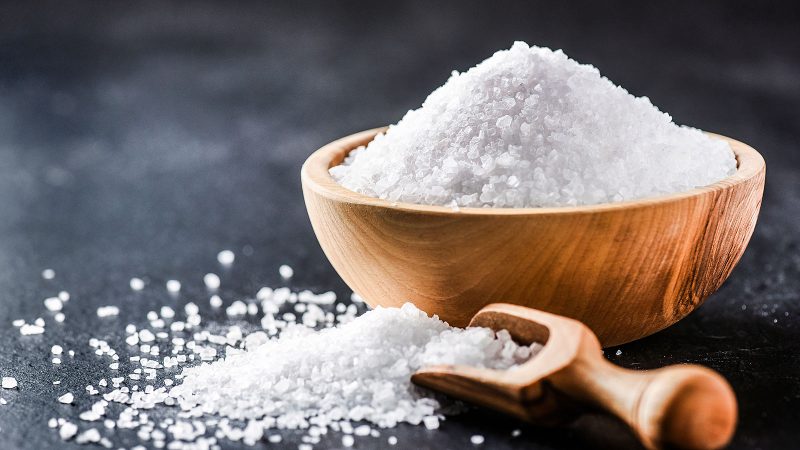Salt – really that harmful?
Salt used to be known as “white gold” . People even use it as a means of payment. Even today, it is hard to imagine our kitchen without salt. But is it really as harmful as it is often claimed? Everything you need to know about salt and how it affects high blood pressure and exercise can be found in our new blog post.
What is actually meant by salt?
Table salt is made up of Sodium Chloride (NaCl) . In the body, this compound dissolves into sodium and chloride. 1 g of sodium chloride consists of 0.4 g of sodium and 0.6 g of chloride. Sodium is primarily responsible for the fluid balance and the transmission of stimuli from muscle and nerve cells . Salt is also a component of digestive juices. In interaction with sodium, chloride regulates the osmotic balance between the inside and outside of the cells. Both minerals are therefore vital for the body. But it depends on the amount!
Salt can be obtained from different sources. The majority of global salt production comes from rock salts , the rest from sea salt and so-called evaporated salts . Salt is thus obtained from underground salt deposits, from the sea or natural brine deposits. In terms of nutritional physiology, however, there are no significant differences between the individual types of salt, as most types of salt consist of around 98% sodium chloride . However, the other two percent as well as the origin of the salt influence the taste.
Table salt is common in Germany enriched with iodine, fluoride or folic acid . Since people in Germany often do not have a sufficient supply of iodine, it makes sense to use iodized salt.
Salt in food production
Salt is one thing in food production important ingredient . Because there is not only taste, but also improves the shelf life . Since salt binds water, it deprives the microorganisms of their livelihood and is therefore conserving in certain quantities. In addition, table salt has a positive effect on the quality of products . It is therefore indispensable for the production of meat and sausage products, cheese and bread. This also explains why foods of animal origin in particular contain a lot of salt. With bread you should make sure that only 1 g of table salt is added per 100 g.
Salt should also enhance the sweet taste , which is why many dessert or cake recipes include a pinch . How exactly the mechanism behind it works is not yet known exactly.
Brand new in our range: Our 6K protein powder in Salted Caramel!
How much salt is healthy?
A daily salt intake of around 1.4 g is probably enough for our body to function. The German Nutrition Society recommends a salt intake of 6 g / day , whereas the WHO recommends only 5 g. A study by the Robert Koch Institute has found that in Germany 75% of men and almost 70% of women eat more daily than the 6 g salt recommended by the DGE; men take an average of 10 g of salt a day and women 8.4 g. Various studies show that too much salt intake can promote diseases such as high blood pressure.
Did you know? Calculated per kilogram of body weight, salt is even more harmful than alcohol. While alcohol 4-6 g per kg body weight leads to death, table salt is only 1-2 g per kg body weight.

Does salt promote high blood pressure?
In Germany, high blood pressure (also called hypertension) is a widespread disease. About 30 million people in Germany suffer from high blood pressure, the number of unreported cases is high. We speak of high blood pressure from a value of 140/90 mm Hg, a value of around 120/80 mm Hg is normal. In the long run, high blood pressure leads to damage to the blood vessels and subsequent diseases such as stroke and heart attack can occur.
Whether salt leads to high blood pressure is not 100% certain. Because high blood pressure is caused by various factors . In particular, hereditary disposition, too little exercise, obesity, an unhealthy diet and stress all promote the disease. One thing is certain: too much salt intake can lead to high blood pressure. One study shows that a salt intake of more than 5 g / day is linked to cardiovascular diseases and strokes. It is also known that high blood pressure patients are particularly sensitive to salt. If table salt is reduced in the diet, blood pressure can be lowered.
However, it must also be said that everyone reacts differently to salt. There are people in whom the blood pressure rises due to table salt in their food, but there are also people in whom there is hardly any effect (salt-resistant). About a third of all people are salt-sensitive. Those affected react strongly to table salt and cannot excrete excess salt as effectively as people who are resistant to salt. This causes the blood pressure to rise. About 50% of people with high blood pressure are salt sensitive. Salt-sensitive people benefit from eating less salt.
But a strictly low-salt diet can also endanger the health of high blood pressure patients. This is shown by a study at the University of Glasgow with over 130,000 participants. The risk of cardiovascular disease in high blood pressure patients was greater if they consumed less than 3 g or more than 7 g salt per day . In addition, a low-salt diet should increase the release of stress hormones into the blood.
Where is there a particularly high amount of salt?
The culprit is not the salt shaker, but finished products as well as fast food. Because processed products contain high amounts of table salt. For example, 80% of the daily salt intake comes from finished products . For example, a frozen pizza with salami already contains the recommended daily intake of 6 g of salt.
In contrast to Germany, there are already initiatives in other European countries to reduce the consumption of salt in the population. Germany too would like to significantly reduce the salt content in finished products in the future.
Salt consumption and exercise
During training, there is a significant loss of salt through sweat, The body loses almost 4 g in an hour during a strenuous workout . This corresponds approximately to a sodium loss of 1500 mg (for comparison: this corresponds to the adequate daily intake of an adult). Sufficient sodium intake both before and after exercise is therefore essential for the body and can delay the state of exhaustion during exercise. Since other minerals are also lost through sweat, our Sport Essentials .
A sufficient one, especially for endurance athletes The intake of salt is important in addition to the intake of fluids, because without sodium the body cannot absorb the water into the cells. So-called water intoxication occurs. In addition, the salt content in the blood drops sharply, headaches and dizziness, up to seizures, fainting and even death can result. Read our blog post about this: Can drinking too much water be harmful? . When exercising, you should make sure that your water contains 400-800 milligrams of sodium per liter . Note that you can not only get sodium through the consumption of salt, foods such as fruits and vegetables also contain sodium.
Furthermore, sodium keeps our bodies in a hydrated state as the blood volume increases becomes. This means that more oxygen and nutrients get into the muscles and waste products are removed more quickly.




